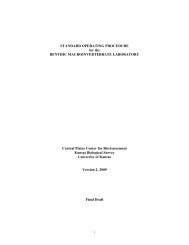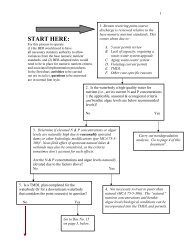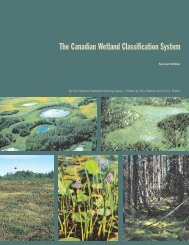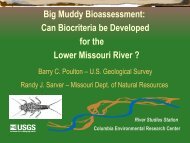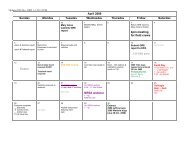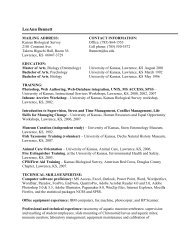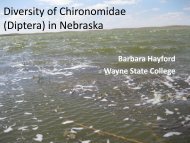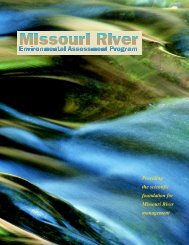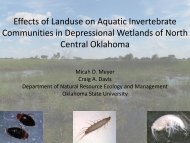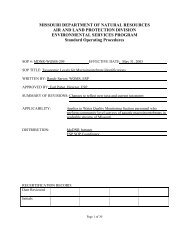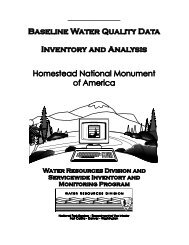Koontz, J., D.G. Huggins, C.C. Freeman, D.S. Baker - Central Plains ...
Koontz, J., D.G. Huggins, C.C. Freeman, D.S. Baker - Central Plains ...
Koontz, J., D.G. Huggins, C.C. Freeman, D.S. Baker - Central Plains ...
Create successful ePaper yourself
Turn your PDF publications into a flip-book with our unique Google optimized e-Paper software.
Executive Summary<br />
This project sought to identify a number of Missouri River floodplain wetlands for monitoring<br />
and assessment of wetland condition using several assessment tools developed in this and a<br />
previous project entitled “Assessment of Floodplain Wetlands of the Lower Missouri River<br />
Using an EMAP Study Approach”(www.cpcb.ku.edu/research/html/ReferenceWetlands.htm).<br />
A number of randomly selected wetlands were identified using the probability-based sampling<br />
design of the EMAP program (www.epa.gov/bioiweb1/statprimer/probability_based.html) and<br />
monitored for four groups of attributes; water quality (e.g. dissolved oxygen, total phosphorus,<br />
herbicides), floristic (native plant richness, percent adventives species), macroinvertebrate<br />
community (taxa richness, sensitive species), and landscape (e.g. buffer condition, disturbance<br />
assessment). A snapshot of the ecological condition of these wetlands were determined using<br />
measures of various factors in the above groupings and these factors used to characterize the<br />
random wetland population (see CDFs, descriptive statistics tables (Tables 3-7), and box plot<br />
figures as examples). In addition a floodplain wetland database and series of GIS shape files of<br />
various wetland and related attributes is available at the CPCB‟s website<br />
(http://www.cpcb.ku.edu/research/html/wetland2.htm) that allow other wetland planners and<br />
managers to access these data to assist in identify wetland condition and relationship that can<br />
affect their management efforts.<br />
In order to accomplish the first objective, the applicability and responses of both previously<br />
determined assessment metrics (such as reference buffer condition, FQA metrics, field<br />
disturbance assessments) and new metrics (this study‟s MMI and macroinvertebrate metrics)<br />
were determined as part of this project. This effort produced a new macroinvertebrate<br />
multimetric index (MMI) and series of metrics that can be used to quantify wetland disturbance<br />
based on reference wetland scores. The disturbance assessment approach (DA) developed as par<br />
to this and the prior floodplain wetland project was found to be useful as a Level II wetland<br />
assessment tool and can be used by others in Region 7 to examine the possible level of<br />
disturbance of individual wetlands occurring in large river floodplains. Lastly, comparisons of<br />
reference and random population wetland conditions using project water quality, floristic and<br />
macroinvertebrate metrics proved useful in identifying a continuum of conditions for these<br />
wetlands from “least disturbed” to disturbed. The development of these tools and their<br />
demonstrated value in determining possible wetland disturbances, quantifying biological and<br />
water quality conditions related to disturbances, and the determination of “reference” conditions<br />
(and wetlands) provides management organizations a new set of tools in developing wetland<br />
plans for floodplain wetlands in EPA Region 7.<br />
Background<br />
In 2007 the <strong>Central</strong> <strong>Plains</strong> Center for BioAssessment (CPCB) at the Kansas Biological Survey<br />
(KBS), University of Kansas, studied a set of 22 reference wetland sites located in the Missouri<br />
River floodplain (Kriz et al. 2007). During that Phase I study, wetland assessment tools were<br />
developed that could be useful for Level 1 (landscape assessment using a geographic information<br />
system (GIS) and remote sensing) studies and could be applicable to Level 2 and Level 3 studies<br />
(see Fennessy et al. 2004). This report describes a Phase II study in which we continued<br />
development of the assessment tools by sampling and analyzing a series of abiotic and biotic<br />
5 of 84



